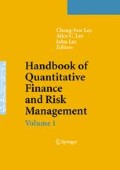Abstract
The payoffs on the expiration dates of Asian options depend on the underlying asset’s average price over some prespecified period rather than on its price at expiration. In this chapter we outline the possible applications of these options and describe the different methodologies and techniques that exist for their evaluation as well as their advantages and disadvantages.
Access this chapter
Tax calculation will be finalised at checkout
Purchases are for personal use only
Notes
- 1.
According to legend such options were originally used in 1987 when Bankers Trust’s Tokyo office used them for pricing average options on crude oil contracts.
- 2.
- 3.
If the option is not newly issued and some of the prices that comprise the average have already been observed, then taking that into account, the strike price and the definition of the random variable are adjusted in a straightforward manner.
- 4.
Turnbull and Wakeman claim however that Kemna and Vorst’s result holds true only if the averaging period starts after the initiation (and valuation) of the options. They provide examples showing that when the time to maturity of the option is lower than the averaging period, the value of the Asian option could be higher than that of a standard European option. Geman and Yor 1993, arrive at a similar conclusion.
References
Ben-Ameur, H., M. Breton, and P. L’Ecuyer. 2002. “A dynamic programming procedure for pricing American-style Asian options.” Management Science 48, 625–643.
Black, F. and M. Scholes. 1973. “The pricing of options and corporate liabilities.” Journal of Political Economy 81, 637–654.
Bouaziz, L., E. Briys, and M. Crouhy. 1994. “The pricing of forward-starting Asian options.” Journal of Banking and Finance 18, 823–839.
Boyle, P. 1977. “Options: a Monte-Carlo approach.” Journal of Financial Economics 4, 323–338.
Carverhill, A. P. and L. J. Clewlow. 1990. “Valuing average rate (‘Asian’) options.” Risk 3, 25–29.
Castellacci, G. M. and J. Siclari. 2003. “Asian basket spreads and other exotic options.” Power Risk Management. http://www.olf.com/news/articles/2005/articles_20050610.aspx
Cummins, D. J. and H. Geman. 1994. “An Asian option approach to the valuation of insurance futures contracts.” Working paper, Financial Institutions Center University of Pennsylvania 03–94.
Curran, M. 1992. “Valuing Asian and portfolio options by conditioning on the geometric mean price.” Management Science 40, 1705–1711.
Dhaene, J., M. Denuit, M. J. Goovaerts, R. Kaas, and D. Vyncke. 2002a. “The concept of comonotonicity in actuarial science and finance: applications.” Insurance Mathematics and Economics 31, 133–161.
Dhaene, J., M. Denuit, M. J. Goovaerts, R. Kaas, and D. Vyncke. 2002b. “The concept of comonotonicity in actuarial science and finance: theory.” Insurance Mathematics and Economics 31, 3–33.
Fu, M., D. Madan, and T. Wang. 1998/1999. “Pricing continuous Asian options: a comparison of Monte Carlo and Laplace transform inversion methods.” The Journal of Computational Finance 2, 49–74.
Geman, H. and M. Yor. 1993. “Bessel processes, Asian options, and perpetuities.” Mathematical Finance 3, 349–375.
Goovaerts, M. J., J. Dhaene, and A. De Schepper. 2000. “Stochastic upper bounds for present value functions.” Journal of Risk and Insurance Theory 67, 1–14.
Hull, J. 2006. Options, Futures, and Other Derivatives, Prentice Hall, NJ.
Hull, J. and A. White. 1993. “Efficient procedures for valuing European and American path-dependent options.” Journal of Derivatives 1, 21–31.
Ingersoll, J. 1987. Theory of Financial Decision Making, Rowman & Littlefield Publishers.
Jacques, M. 1996. “On the hedging portfolio of Asian options” ASTIN Bulletin 26, 165–183.
Kaas, R., J. Dhaene, M. J. Goovaerts 2000. “Upper and lower bounds for sums of random variables.” Insurance: Mathematics and Economics 27, 151–168.
Kemna, A. G. Z. and A. C. F. Vorst 1990. “A pricing method for options based on average asset values.” Journal of Banking and Finance 14, 113–129.
Levy, E. 1992. “Pricing European average rate currency options” Journal of International Money and Finance 11, 474–491.
Linetsky, V. 2002. “Exact pricing of Asian options: an application of spectral theory,” Working Paper, Northwestern University.
Longstaff, F. A. and E. S. Schwartz 2001. “The Review of Financial Studies” 14, 113–147.
Rogers, L. and Z. Shi 1995. “The value of an Asian option” Journal of Applied Probability 32, 1077–1088.
Turnbull, S. M. and L. M. Wakeman 1991. “A quick algorithm for pricing European average options.” Journal of Financial and Quantitative Analysis 26, 377–389.
Vecer, J. 2001. “A new PDE approach for pricing arithmetic average Asian options.” The Journal of Computational Finance 4, 105–113.
Zhang, P. 1995. “Flexible arithmetic Asian options.” Journal of Derivatives 2, 53–63.
Author information
Authors and Affiliations
Corresponding author
Editor information
Editors and Affiliations
Rights and permissions
Copyright information
© 2010 Springer Science+Business Media, LLC
About this chapter
Cite this chapter
Venezia, I. (2010). Asian Options. In: Lee, CF., Lee, A.C., Lee, J. (eds) Handbook of Quantitative Finance and Risk Management. Springer, Boston, MA. https://doi.org/10.1007/978-0-387-77117-5_39
Download citation
DOI: https://doi.org/10.1007/978-0-387-77117-5_39
Publisher Name: Springer, Boston, MA
Print ISBN: 978-0-387-77116-8
Online ISBN: 978-0-387-77117-5
eBook Packages: Business and EconomicsEconomics and Finance (R0)

